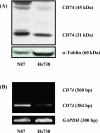Suppressive Effects of Selected Food Phytochemicals on CD74 Expression in NCI-N87 Gastric Carcinoma Cells
- PMID: 18818744
- PMCID: PMC2533715
- DOI: 10.3164/jcbn.2008054
Suppressive Effects of Selected Food Phytochemicals on CD74 Expression in NCI-N87 Gastric Carcinoma Cells
Abstract
Helicobacter pylori (H. pylori) is one of the most widespread human pathogens, and plays major roles in chronic gastritis and gastric cancer. CD74 of gastric epithelial cells has recently been identified as an adhesion molecule to urease in H. pylori. In this study, we found that CD74 is highly expressed in a constitutive manner in NCI-N87 human gastric carcinoma cells at both the protein and mRNA levels as compared with Hs738St./Int fetal gastric cells. Subsequently, a novel cell-based ELISA able to rapidly screen the suppressive agents of CD74 expression was established. NCI-N87 cells were treated separately with 25 different food phytochemicals (4-100 microM) for 48 h and subjected to our novel assay. From those results, a citrus coumarin, bergamottin, was indicated to be the most promising compound with an LC(50)/IC(50) value greater than 7.1, followed by luteolin (>5.4), nobiletin (>5.3), and quercetin (>5.1). Our findings suggest that these CD74 suppressants are unique candidates for preventing H. pylori adhesion and subsequent infection with reasonable action mechanisms.
Keywords: CD74; Helicobacter pylori; adhesion; bergamottin; cell-based ELISA.
Figures


Similar articles
-
Suppression of CD74 expression and Helicobacter pylori adhesion by auraptene targeting serum starvation-activated ERK1/2 in NCI-N87 gastric carcinoma cells.Biosci Biotechnol Biochem. 2010;74(5):1018-24. doi: 10.1271/bbb.90910. Epub 2010 May 7. Biosci Biotechnol Biochem. 2010. PMID: 20460732
-
Helicobacter pylori-induced IL-8 production by gastric epithelial cells up-regulates CD74 expression.J Immunol. 2005 Jul 1;175(1):171-6. doi: 10.4049/jimmunol.175.1.171. J Immunol. 2005. PMID: 15972644
-
New NCI-N87-derived human gastric epithelial line after human telomerase catalytic subunit over-expression.World J Gastroenterol. 2015 Jun 7;21(21):6526-42. doi: 10.3748/wjg.v21.i21.6526. World J Gastroenterol. 2015. PMID: 26074691 Free PMC article.
-
The Helicobacter pylori urease B subunit binds to CD74 on gastric epithelial cells and induces NF-kappaB activation and interleukin-8 production.Infect Immun. 2006 Feb;74(2):1148-55. doi: 10.1128/IAI.74.2.1148-1155.2006. Infect Immun. 2006. PMID: 16428763 Free PMC article.
-
[Helicobacter pylori in peptic ulcer and gastric cancer].Gan To Kagaku Ryoho. 1995 Feb;22(2):169-78. Gan To Kagaku Ryoho. 1995. PMID: 7857088 Review. Japanese.
Cited by
-
Phytochemicals for the Prevention and Treatment of Gastric Cancer: Effects and Mechanisms.Int J Mol Sci. 2020 Jan 16;21(2):570. doi: 10.3390/ijms21020570. Int J Mol Sci. 2020. PMID: 31963129 Free PMC article. Review.
-
Effectiveness of Citrus Fruits on Helicobacter pylori.Evid Based Complement Alternat Med. 2017;2017:8379262. doi: 10.1155/2017/8379262. Epub 2017 Mar 20. Evid Based Complement Alternat Med. 2017. PMID: 28408943 Free PMC article. Review.
-
Chemistry and health effects of furanocoumarins in grapefruit.J Food Drug Anal. 2017 Jan;25(1):71-83. doi: 10.1016/j.jfda.2016.11.008. Epub 2016 Dec 6. J Food Drug Anal. 2017. PMID: 28911545 Free PMC article. Review.
-
Growth inhibitory, bactericidal, and morphostructural effects of dehydrocostus lactone from Magnolia sieboldii Leaves on antibiotic-susceptible and -resistant strains of Helicobacter pylori.PLoS One. 2014 Apr 18;9(4):e95530. doi: 10.1371/journal.pone.0095530. eCollection 2014. PLoS One. 2014. PMID: 24747984 Free PMC article.
-
Bergamottin, a bioactive component of bergamot, inhibits SARS-CoV-2 infection in golden Syrian hamsters.Antiviral Res. 2022 Aug;204:105365. doi: 10.1016/j.antiviral.2022.105365. Epub 2022 Jun 19. Antiviral Res. 2022. PMID: 35732228 Free PMC article.
References
-
- Parsonnet J., Friedman G.D., Vandersteen D.P., Chang Y., Vogelman J.H., Orentreich N., Sibley R.K. Helicobacter pylori infection and the risk of gastric carcinoma. N. Engl. J. Med. 1991;325:1127–1131. - PubMed
-
- Nomura A., Stemmermann G.N., Chyou P.H., Kato I., Perez-Perez G.I., Blaser M.J. Helicobacter pylori infection and gastric carcinoma among Japanese Americans in Hawaii. N. Engl. J. Med. 1991;325:1132–1136. - PubMed
-
- Debets-Ossenkopp Y.J., Sparrius M., Kusters J.G., Kolkman J.J., Vandenbroucke-Grauls C.M. Mechanism of clarithromycin resistance in clinical isolates of Helicobacter pylori. FEMS Microbiol. Lett. 1996;142:37–42. - PubMed

